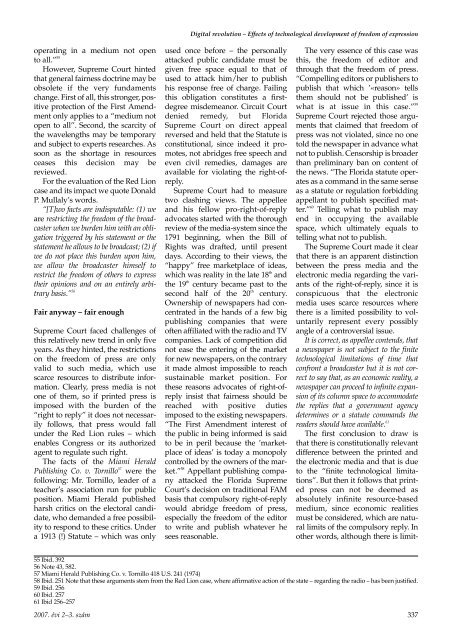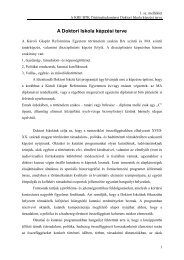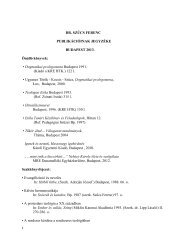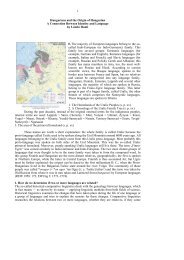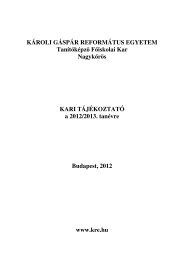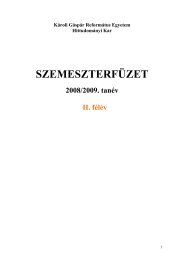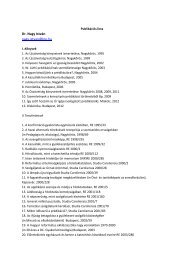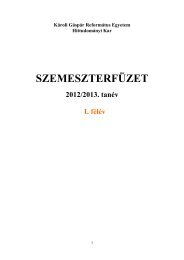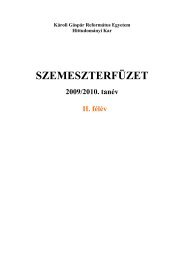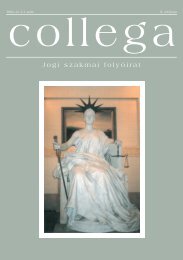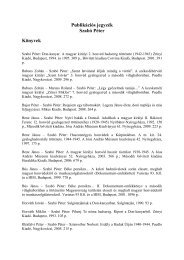collega - Károli Gáspár Református Egyetem
collega - Károli Gáspár Református Egyetem
collega - Károli Gáspár Református Egyetem
Create successful ePaper yourself
Turn your PDF publications into a flip-book with our unique Google optimized e-Paper software.
Digital revolution – Effects of technological development of freedom of expression<br />
operating in a medium not open<br />
to all.” 55<br />
However, Supreme Court hinted<br />
that general fairness doctrine may be<br />
obsolete if the very fundaments<br />
change. First of all, this stronger, positive<br />
protection of the First Amendment<br />
only applies to a “medium not<br />
open to all”. Second, the scarcity of<br />
the wavelengths may be temporary<br />
and subject to experts researches. As<br />
soon as the shortage in resources<br />
ceases this decision may be<br />
reviewed.<br />
For the evaluation of the Red Lion<br />
case and its impact we quote Donald<br />
P. Mullaly’s words.<br />
“[T]wo facts are indisputable: (1) we<br />
are restricting the freedom of the broadcaster<br />
when we burden him with an obligation<br />
triggered by his statement or the<br />
statement he allows to be broadcast; (2) if<br />
we do not place this burden upon him,<br />
we allow the broadcaster himself to<br />
restrict the freedom of others to express<br />
their opinions and on an entirely arbitrary<br />
basis.” 56<br />
Fair anyway – fair enough<br />
Supreme Court faced challenges of<br />
this relatively new trend in only five<br />
years. As they hinted, the restrictions<br />
on the freedom of press are only<br />
valid to such media, which use<br />
scarce resources to distribute information.<br />
Clearly, press media is not<br />
one of them, so if printed press is<br />
imposed with the burden of the<br />
“right to reply” it does not necessarily<br />
follows, that press would fall<br />
under the Red Lion rules – which<br />
enables Congress or its authorized<br />
agent to regulate such right.<br />
The facts of the Miami Herald<br />
Publishing Co. v. Tornillo 57<br />
were the<br />
following: Mr. Tornillo, leader of a<br />
teacher’s association run for public<br />
position. Miami Herald published<br />
harsh critics on the electoral candidate,<br />
who demanded a free possibility<br />
to respond to these critics. Under<br />
a 1913 (!) Statute – which was only<br />
used once before – the personally<br />
attacked public candidate must be<br />
given free space equal to that of<br />
used to attack him/her to publish<br />
his response free of charge. Failing<br />
this obligation constitutes a firstdegree<br />
misdemeanor. Circuit Court<br />
denied remedy, but Florida<br />
Supreme Court on direct appeal<br />
reversed and held that the Statute is<br />
constitutional, since indeed it promotes,<br />
not abridges free speech and<br />
even civil remedies, damages are<br />
available for violating the right-ofreply.<br />
Supreme Court had to measure<br />
two clashing views. The appellee<br />
and his fellow pro-right-of-reply<br />
advocates started with the thorough<br />
review of the media-system since the<br />
1791 beginning, when the Bill of<br />
Rights was drafted, until present<br />
days. According to their views, the<br />
“happy” free marketplace of ideas,<br />
which was reality in the late 18 th and<br />
the 19 th<br />
century became past to the<br />
second half of the 20 th<br />
century.<br />
Ownership of newspapers had concentrated<br />
in the hands of a few big<br />
publishing companies that were<br />
often affiliated with the radio and TV<br />
companies. Lack of competition did<br />
not ease the entering of the market<br />
for new newspapers, on the contrary<br />
it made almost impossible to reach<br />
sustainable market position. For<br />
these reasons advocates of right-ofreply<br />
insist that fairness should be<br />
reached with positive duties<br />
imposed to the existing newspapers.<br />
“The First Amendment interest of<br />
the public in being informed is said<br />
to be in peril because the ’marketplace<br />
of ideas’ is today a monopoly<br />
controlled by the owners of the market.”<br />
58 Appellant publishing company<br />
attacked the Florida Supreme<br />
Court’s decision on traditional FAM<br />
basis that compulsory right-of-reply<br />
would abridge freedom of press,<br />
especially the freedom of the editor<br />
to write and publish whatever he<br />
sees reasonable.<br />
The very essence of this case was<br />
this, the freedom of editor and<br />
through that the freedom of press.<br />
“Compelling editors or publishers to<br />
publish that which ’«reason» tells<br />
them should not be published’ is<br />
what is at issue in this case.” 59<br />
Supreme Court rejected those arguments<br />
that claimed that freedom of<br />
press was not violated, since no one<br />
told the newspaper in advance what<br />
not to publish. Censorship is broader<br />
than preliminary ban on content of<br />
the news. “The Florida statute operates<br />
as a command in the same sense<br />
as a statute or regulation forbidding<br />
appellant to publish specified matter.”<br />
60<br />
Telling what to publish may<br />
end in occupying the available<br />
space, which ultimately equals to<br />
telling what not to publish.<br />
The Supreme Court made it clear<br />
that there is an apparent distinction<br />
between the press media and the<br />
electronic media regarding the variants<br />
of the right-of-reply, since it is<br />
conspicuous that the electronic<br />
media uses scarce resources where<br />
there is a limited possibility to voluntarily<br />
represent every possibly<br />
angle of a controversial issue.<br />
It is correct, as appellee contends, that<br />
a newspaper is not subject to the finite<br />
technological limitations of time that<br />
confront a broadcaster but it is not correct<br />
to say that, as an economic reality, a<br />
newspaper can proceed to infinite expansion<br />
of its column space to accommodate<br />
the replies that a government agency<br />
determines or a statute commands the<br />
readers should have available. 61<br />
The first conclusion to draw is<br />
that there is constitutionally relevant<br />
difference between the printed and<br />
the electronic media and that is due<br />
to the “finite technological limitations”.<br />
But then it follows that printed<br />
press can not be deemed as<br />
absolutely infinite resource-based<br />
medium, since economic realities<br />
must be considered, which are natural<br />
limits of the compulsory reply. In<br />
other words, although there is limit-<br />
55 Ibid. 392<br />
56 Note 43, 582.<br />
57 Miami Herald Publishing Co. v. Tornillo 418 U.S. 241 (1974)<br />
58 Ibid. 251 Note that these arguments stem from the Red Lion case, where affirmative action of the state – regarding the radio – has been justified.<br />
59 Ibid. 256<br />
60 Ibid. 257<br />
61 Ibid 256–257<br />
2007. évi 2–3. szám<br />
337


